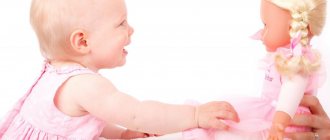▣ SUBSCRIBE ON INSTAGRAM➥
2018-02-09 11:04:40 0 7108
Educational toys, invented by the talented Italian teacher Maria Montessori more than a hundred years ago, are very, very popular among modern parents and children. Which is quite natural: these educational toys are bright, simple and at the same time interesting and useful for both the youngest and older children!
Insert frames are very diverse. They differ from each other in shape, theme, age purpose, technical design (for example, wooden frames-inlays). Whatever the toy, the main thing is that it brings great benefits to the baby. The main task of the game is to return the cut out small part to its place, after first matching the shape and size of the element and the “house” for it. In some toys, it is possible to navigate by the meaning of the picture, while in others, shape and size are the only defining characteristics. Interesting, isn't it?
For example, simple frame inserts can be offered to babies from 6 to 8 months, and more serious options will captivate children up to 5 to 6 years old!
The toy is a tablet-like tablet with parts of different shapes cut out in it. They can be taken out of the frame and put back in place. Most often, the parts are equipped with a button-handle, which makes them very convenient to grasp. But there is a secret in the purpose of this button: it is not only for convenience! The fact is that the baby grasps the button with three fingers: thumb, index, middle - that is, those with which he will later hold a pencil and pen!
Did you guess it? The main benefits of frame inserts:
- fine motor skills training;
- Preparing the baby's hand for writing.
But that's not all! Frame inserts:
- They develop logic and coordination of the tiny baby’s movements (it’s not so easy to get a piece into a frame, and you also have to figure out how to turn it correctly so that it fits into place!).
- They teach you to distinguish geometric shapes, sizes, colors, and help you learn to count.
- With the help of insert frames, you can clearly explain to your child the concept of “whole” and “fraction”. There is an option where you need to insert a whole circle into the frame, next to it is a circle consisting of two halves, then three, four, and so on! There are a total of 72 elements in this constructor! Of course, this model is not suitable for the tiniest.
- Thematic frame inserts introduce the baby to the world of animals, technology, vegetables and fruits, even geography! While playing, the baby will easily remember, for example, that banana, pear and apple can be called the general word “fruit”.
- the baby becomes more inquisitive and expands his vocabulary.
This is what a powerful developmental potential lies in a simple-looking toy!
And now we need to find out what types of frames and inserts there are in order to choose the right option for the baby in accordance with his tastes and age.
INSERT FRAMES ARE MORE OR LESS.
In one frame there are four identical in appearance, but different in size bunnies, dogs or other animals. The task is to put the pieces in their places. This version of the insert frame can be given to a baby as early as six months, but, of course, you shouldn’t expect the baby to immediately arrange everything on his own! The baby will be able to do everything himself later, when he’s a year and a half old, but for now, moms and dads, play with him!
THEMED FRAME INSERTS.
Frames with inserts in the form of figurines, animals, gifts of nature, cars will be of interest to daughters and sons from 1.5 to 2 years old. The option of a frame with an underlayer simplifies the task for children - a similar pattern is applied in the slots of the frame to facilitate the selection of parts.
For two to three year old children, more complex options are suitable - geometric shapes divided into parts by straight or wavy lines; with numbers and letters that need to be placed in the corresponding silhouettes.
DRESSING FRAMES.
Children really like to match blouses and pants to the figures of children or animals, as well as different faces: funny, angry, surprised! By playing with “dress up”, you can learn very, very many important, interesting things. For example, learning the names of items of clothing, getting to know the seasons, and faces will help the baby recognize various emotions. The game will be much more exciting with mom’s comments: “The bear is going for a winter walk. What should I take – maybe some pajamas?” Of course, the baby will choose a fur suit with a satisfied smile! You can write whole stories on the topic of how the bear got up, took off his pajamas, put on something appropriate for the season, went for a walk, got scared, for example, of a caterpillar, and then realized that there was nothing to be afraid of and laughed... Use your imagination and play with the insert frame will take on new dimensions!
GEOGRAPHICAL INSERT MAPS
– the most interesting Montessori idea! This frame is intended for older children, but will be interesting even for adults. It's really fun to arrange the continents in their places on the hemispheres! A great way to learn geography. By the way, it was prefabricated geographical maps for children, which appeared at the end of the 18th century, that are the “great-grandfathers” of modern puzzles! Interested?
We will be very glad if you and your children enjoy these games.
We wish you exciting games and great success!
DIY educational games
It would seem that now you can buy almost any toys.
Why reinvent the wheel and engage in amateur activities? But games made by mother’s hands always enjoy special love from the baby, and even if they turn out not quite perfect, they are certainly original and with a considerable share of mother’s warmth and love. Plus, in the current uncertain economic climate, homemade toys can help you save some money to buy something more worthwhile, like children's books.
I admit that I do not belong to the category of handicraft mothers, rather the opposite. But with the birth of my daughter, the situation suddenly changed: I wanted to create something (or at least try to do it), tinker, invent. As it turned out, this requires a minimum of time and material costs, and the child’s enthusiastic reaction is the most pleasant reward.
Tactile bags
To make them you will need some colorful scraps and various fillings: cereals, beans, pebbles, rustling polyethylene, cotton wool, salt, small coins, etc. It is advisable to choose fabric of bright colors and different textures. You can also sew two-color bags.
Just cut out squares from the fabric, for example, 8x8 cm + 0.5 cm for allowances on each side. Sew the bags, leaving a small hole, turn them inside out, fill them with stuffing and sew up the hole. The baby will be interested in exploring rustling, ringing, crispy bright toys.
DIY educational games and aids
I would like to show our games for the development of auditory perception, promoting the development of speech and hearing, training in the development of color perception, intelligence and memory.
I'll start, perhaps, with such a thing as auditory perception. I wrote in detail here. Montessori noise cylinders.
The age stated by Mrs. Montessori for playing with noise cylinders is 3 years and above. We started at 2 years old, adapting it to suit our age. I made only 4 cylinders under the red markings and the same 4 cylinders under the green markings.
That's enough for us for now. As practice has shown, you can start with 2-3 things to begin with. If you start carefully, your child will be unstoppable. I don’t know why, this game reminds me of our children’s “Broken Phone”.
We play like this: I show Arina how I take out and listen to the cylinder: I bring it to one ear and shake it, then I do the same at the second ear. I suggest she do the same. She listens to all 4 cylinders in turn. I ask questions: “Which one is louder and which one is quieter? What does the noise sound like? Then we try to look for the same noise among the cylinders with green markings (they contain exactly the same fillers).
I ask questions as she holds two different cylinders in her hands: “Do they make the same noise?” If the cylinder makes a different noise, put it back in the box and take another one. And so we take it out until we pick a pair.
Nikitin squares. Official site .
Nikitin squares are a wonderful tool for developing intelligence. I am also interested in the fact that the gradual solution of problems of the first level smoothly leads to the next, more complex ones. I made the diagrams in the Coral program. Download.
Of course, at 2 years old, we solve first-level problems. But, day after day, there are results. And they make you happy. First I made these squares on magnetic paper.
Nothing worked right away (even for me).
In practice, I realized that they must be voluminous and not cardboard. Therefore, I made it from foamiran 3-4 mm thick. These are very comfortable.
Foam kitchen napkins are also suitable. This is how we put it together. So far, 2-3 squares at a time.
The Nikitins have developed a whole system of classes with these things. He suggests starting by sorting by color. To do this you need to have squares of different colors. We have been sorting by color for a long time, we are no longer interested.
Cuisenaire sticks. I think no one will be indifferent to these little bars. We are no exception. At first we arranged them by color.
Then we found diagrams on the internet. Download. Upon closer examination of the diagrams, it turned out that they were complex for a 2-year-old. I began to draw diagrams “by hand” on checkered pieces of paper, having first measured the sticks themselves.
Then I drew beautiful ones in the Coral program. Download.
The game itself is a good tool for learning mathematics, quantities, and segments. Develops imagination.




